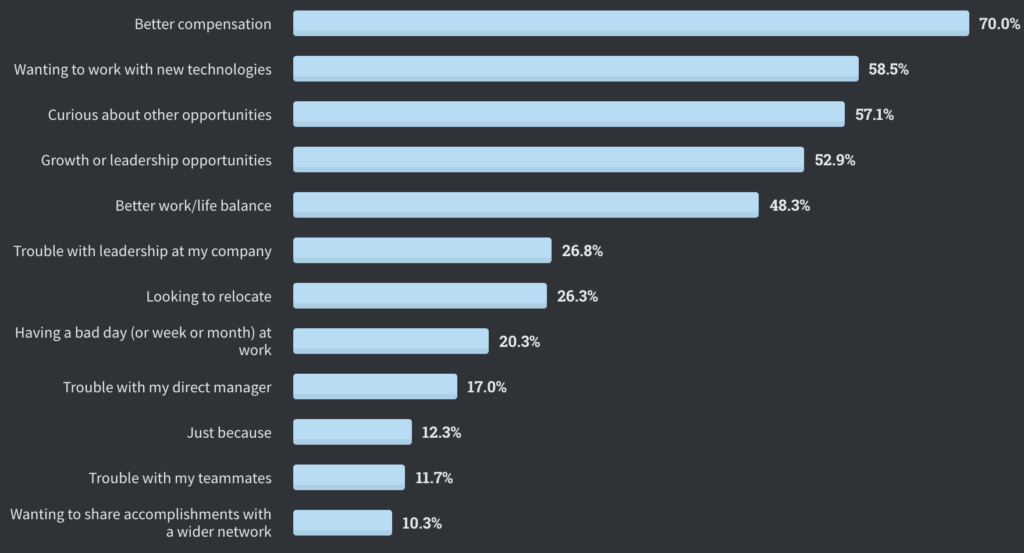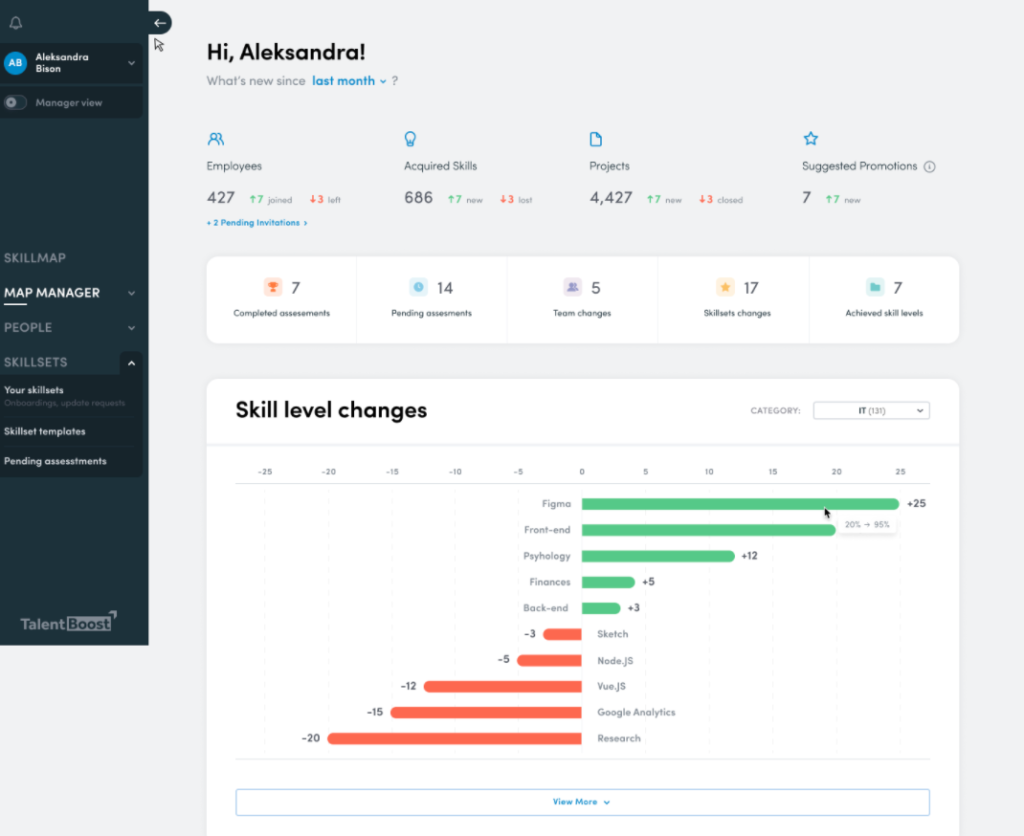What is competency management and how to do it well

The war for tech talent is fierce. To win, employers not only have to optimize their recruitment to hire the best talent fast, but they also have to put an effective competency management system in place to manage employee growth and keep their tech stack relevant.
In the following article, we’re going to cover what the competency management process is, its benefits, and share with you a few tips to optimize your competency management strategy.
What is competency management?
Before we provide you with a more competency model, and management definition it’s worth answering a question – what is competency?
Competency is the knowledge, abilities, competencies required for, and expertise that an individual or an organization has.
Competency management is about understanding and using a competency framework defining the skills that an employee needs in order to effectively perform their job, improving and optimizing those skills so they fully support company growth. Competency management insights can be used for workforce planning, talent acquisition, succession management, and more.
Why is competency management important in tech?
Tech talent goes off the market incredibly fast, this is particularly true when it comes to developers, for whom switching jobs comes easily due to high demand. If employers want to attract the best tech talent, they should provide continuous, learning and development opportunities. Without a doubt, programmers care about the organization’s tech stack. According to Stack Overflow, it’s the second most important factor for a job change.

Source: Stack Overflow
Competency management allows organizations to more effectively manage the knowledge and skills of their employees, which in turn provides better opportunities for learning and growth. This has a positive impact on your recruitment efforts and talent retention, which brings us to the discussion about the benefits of competency-based management.
The benefits of competency management
Boost in employee retention
Employee retention is one of the biggest challenges in IT recruitment. As sourcing and recruiting talent is a lengthy and costly process, you’ll want to make sure that your employees will stay at your organization for as long as possible. This can certainly be achieved with a competency program in place.

Source: DevSkiller
If your employees see that management cares about their careers, they are more likely to stay with your organization longer. Among others, this means minimizing the risk of employees leaving as soon as you’ve invested in their training. What’s more, according to a report by Development Dimensions International, investing in a competency management system also increases the chances of developing future leaders within your organization by an impressive 156%.
Increased team productivity
Another perk of creating a workforce competency program is a spike in employee motivation. There are two factors worth mentioning here – career and development plans and company transparency.
Firstly, according to Stack Overflow, opportunities for professional development are the fourth most important career value for IT staff, standing at 41.4%. This means that, if an organization creates career paths and invests in training, employees will be more prone to perform at their best. Secondly, if a business is open about its financial and market objectives, employees will understand how their work contributes to the company, which will also have a positive impact on productivity.
Optimizing recruitment and training costs
If you use a competency mapping tool like TalentBoost, another benefit will be significant savings in your recruitment and talent development efforts.
As your HR team will get a bird’s eye view of the skills-required competencies that your team already possesses or wants to acquire, you might uncover that you don’t need to hire externally after all. Instead, you might need to focus on training and internal events such as hackathons to strengthen your team’s skill set. This results in major cost savings in talent sourcing and recruitment, which we discuss in more detail in the next section.

Source: Unsplash
Better hiring decisions
Making hiring mistakes can be extremely costly. According to Career Builder, 74% of companies that made a bad hiring decision on average lost $14,900 per hire. What’s even more worrying is that 80% of employee turnover is due to recruiting the wrong people.
Competence management makes you aware of your team’s skills and career paths. This, in turn, helps you make sure that each new team member you hire genuinely adds value to the business. Competency-based management plays a key role in ensuring that the candidates you recruit are the right fit, i.e., they’re neither overqualified nor underqualified. While also paying attention to your current employees and looking after their skills growth, to optimize hiring.

Source: TalentBoost
If you want to grow as an organization then you have to make sure that your workforce’s skill set is in line with your business goals. Let’s assume you aspire to be a leader in a given technology in 2-3 years. To fulfill this aim, you have to know which skills you have at your disposal, which are missing, as well as decide how to fill those skill gaps – internally or externally. Having a well competency development program in place will assist you in aligning your training and hiring strategy with your company goals. What’s more, tracking how the skills within your organization evolve will help you understand if you’re on the right path and adjust accordingly, if necessary.
Better succession planning
Another benefit of effective competence management is better succession planning. It’s expensive and time-consuming to hire employees, especially more senior ones. Luckily, you don’t always have to seek talent externally. Being aware of your employee’s skills and their career goals will help you decide on who deserves a promotion. They’ll also point to those who need to be further trained to be able to take over for the employee who is leaving. This will have a positive impact on succession planning.
How to optimize your competency management strategy
Get internal buy-in from leadership
Competency management should not be the responsibility of the HR department alone. Suppose your company’s leaders don’t show that they care about their employees’ careers and that they value their role in the business. In that case, your competence development program likely won’t succeed or be credible in your team’s eyes.
Conduct skills assessments
Run soft skills & hard skills assessments; use a tool like TalentScore to run work sample coding tests, which will automatically allow you to score your developers’ skills. With these results at hand, you’ll be able to discuss career advancements and evaluate the necessary training/support your employees will need to become more proficient at their job roles and particular languages and technologies.
Use a competency management tool
With competency management solutions like TalentBoost, you can manage competencies on a per employee and per team basis by providing a bird’s eye view of what your team can and cannot do. It’s the best way to spot any skill gaps and decide which competencies should be acquired first. It will also help you decide how to eliminate skill gaps – either by training or external hiring. By continuously keeping track of your competency frameworks and employee skills, you’ll be able to adjust your competency management strategy whenever needed.

Source: TalentScore
Conduct regular evaluations to collect feedback
Make sure that you conduct regular meetings with your employees. Yearly evaluations won’t suffice if you want to make sure your team’s competence development is on track. In fact, some companies, like Zapier and Automattic, make sure to check in with their team members at least once a week to see how they’re doing.
Make sure your HR and/or direct managers collect feedback from employees regarding their career advancements, as this will allow you to optimize your competency management plan. To make the feedback easier to act on, consider retesting employees who participate in training in the skills they’ve recently acquired. This will allow you to evaluate the effectiveness of your training and other skill development initiatives.
Summary
The key to organizational growth is establishing an effective competency management program for your team. Among others, competency management aligns your employees’ skills with company objectives, lowers team attrition rate, boosts employee performance, and helps in effective succession planning.
To ensure that your competency management strategy supports your company goals, you must start off by getting your C-suite leaders on board. As employees look up to leadership, talent and competency management systems cannot be an effort confined to HR and team leaders.
Secondly, you must implement regular performance reviews and organize one-on-one meetings to continuously collect feedback from employees. While yearly evaluations are an important element of your business, they won’t suffice if you wish to maintain high enough employee engagement and satisfaction and boost team performance.
Thirdly, it’s instrumental that you use the right competency mapping tool. A solution like TalentBoost will provide an overview of the skill set on a per-employee and per-team basis, give you the ability to genuinely establish your hiring needs, spot skills gaps, further employee development and design more effective career paths.
Image credit: Unsplash
Share post